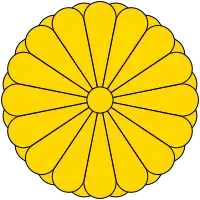تصرف سنگاپور توسط ژاپن
تصرف سنگاپور توسط ژاپن (انگلیسی: Japanese occupation of Singapore) اشغال و تحت کنترل گرفتن سنگاپور توسط امپراتوری ژاپن پس از سقوط و تسلیم نیروهای نظامی انگلیس در ۱۵ فوریه ۱۹۴۲ در طول جنگ جهانی دوم بود.
Syonan-to 昭南島 Shōnantō Japanese-occupied Singapore | |||||||||
|---|---|---|---|---|---|---|---|---|---|
| ۱۹۴۲–۱۹۴۵ | |||||||||
 Imperial Seal
| |||||||||
_-_SGP_-_UNOCHA.svg.png.webp) | |||||||||
.svg.png.webp) The Empire of Japan at its peak in 1942:
Territory (1870–1895) Acquisitions (1895–1930) Acquisitions (1930–1942) | |||||||||
| وضعیت | Military occupation by the امپراتوری ژاپن | ||||||||
| پایتخت و بزرگترین شهر | Singapore ۱°۱۷′ شمالی ۱۰۳°۵۰′ شرقی | ||||||||
| Official language and national language | زبان ژاپنی | ||||||||
| Common languages | زبان چینی، زبان مالایی، زبان تامیلی، زبان انگلیسی | ||||||||
| دین(ها) | دین رسمی: None دفاکتو: شینتوی حکومتی[nb 1] | ||||||||
| حکومت | Military occupation by a نظام تکحزبی تمامیتخواهی دیکتاتوری نظامی under an پادشاهی مطلقه | ||||||||
| فهرست امپراتوران ژاپن | |||||||||
• ۱۹۴۲–۱۹۴۵ | هیروهیتو | ||||||||
| فهرست نخستوزیران ژاپن | |||||||||
• ۱۹۴۲–۱۹۴۴ | توجو هیدکی | ||||||||
• ۱۹۴۴–۱۹۴۵ | کوایسو کونیآکی | ||||||||
| دوره تاریخی | World War II | ||||||||
• آغاز جنگ اقیانوس آرام | 8 December 1941a | ||||||||
۱۵ فوریه ۱۹۴۲ | |||||||||
• Allied bombing raids | نوامبر ۱۹۴۴ – مه ۱۹۴۵ | ||||||||
| ۱۵ اوت ۱۹۴۵ | |||||||||
• Singapore surrendered to British Military Administration | 12 September ۱۹۴۵ | ||||||||
• Singapore becomes a مستعمره تاج | ۱ آوریل ۱۹۴۶ | ||||||||
| واحد پول | Japanese-issued dollar | ||||||||
| منطقه زمانی | یوتیسی+۹ (زمان استاندارد ژاپن) | ||||||||
| گاهشماری |
| ||||||||
| جهت رانندگی | جهت رانندگی در کشورهای مختلف | ||||||||
| کد ایزو ۳۱۶۶ | JP | ||||||||
| |||||||||
| امروز بخشی از | |||||||||
| |||||||||
منابع
- "Explore Japan National Flag and National Anthem". Retrieved 29 January 2017.
- "National Symbols". Archived from the original on 2 February 2017. Retrieved 29 January 2017.
- Josephson, Jason Ānanda (2012). The Invention of Religion in Japan. University of Chicago Press. p. 133. ISBN 978-0-226-41234-4.
- Thomas, Jolyon Baraka (2014). Japan's Preoccupation with Religious Freedom (Ph.D.). Princeton University. p. 76.
- مشارکتکنندگان ویکیپدیا. «Japanese occupation of Singapore». در دانشنامهٔ ویکیپدیای انگلیسی، بازبینیشده در ۲۱ مه ۲۰۲۱.
پیوند به بیرون
| در ویکیانبار پروندههایی دربارهٔ تصرف سنگاپور توسط ژاپن موجود است. |
- Although the Empire of Japan officially had no state religion,[3][4] شینتو played an important part for the Japanese state: As Marius Jansen, states: "The Meiji government had from the first incorporated, and in a sense created, Shinto, and utilized its tales of the divine origin of the ruling house as the core of its ritual addressed to ancestors "of ages past." As the Japanese empire grew the affirmation of a divine mission for the Japanese race was emphasized more strongly. Shinto was imposed on colonial lands in Taiwan and Korea, and public funds were utilized to build and maintain new shrines there. Shinto priests were attached to army units as chaplains, and the cult of war dead, enshrined at the Yasukuni Jinja in Tokyo, took on ever greater proportions as their number grew."(Marius B. Jansen 2002, p. ۶۶۹)
This article is issued from Wikipedia. The text is licensed under Creative Commons - Attribution - Sharealike. Additional terms may apply for the media files.
.svg.png.webp)
